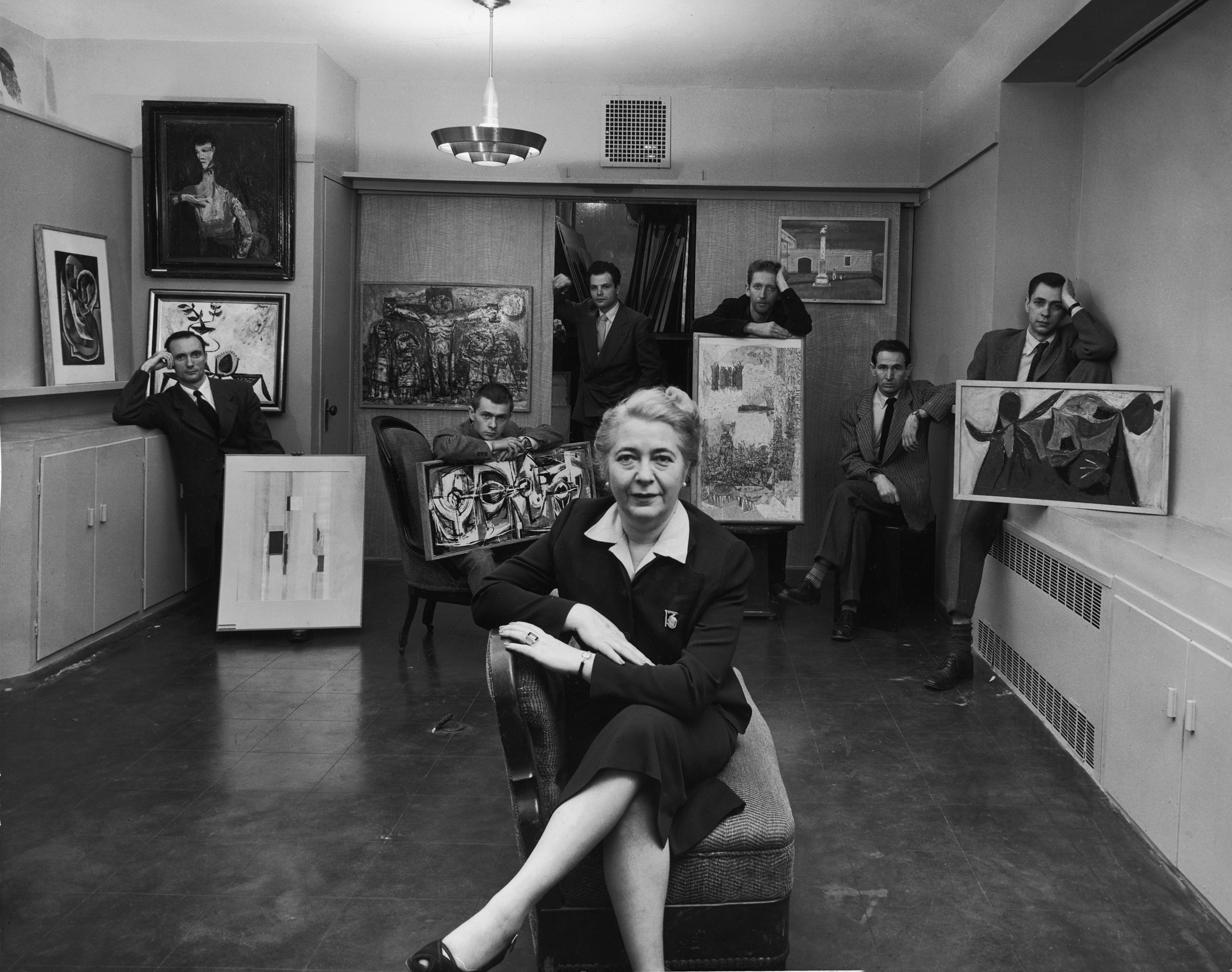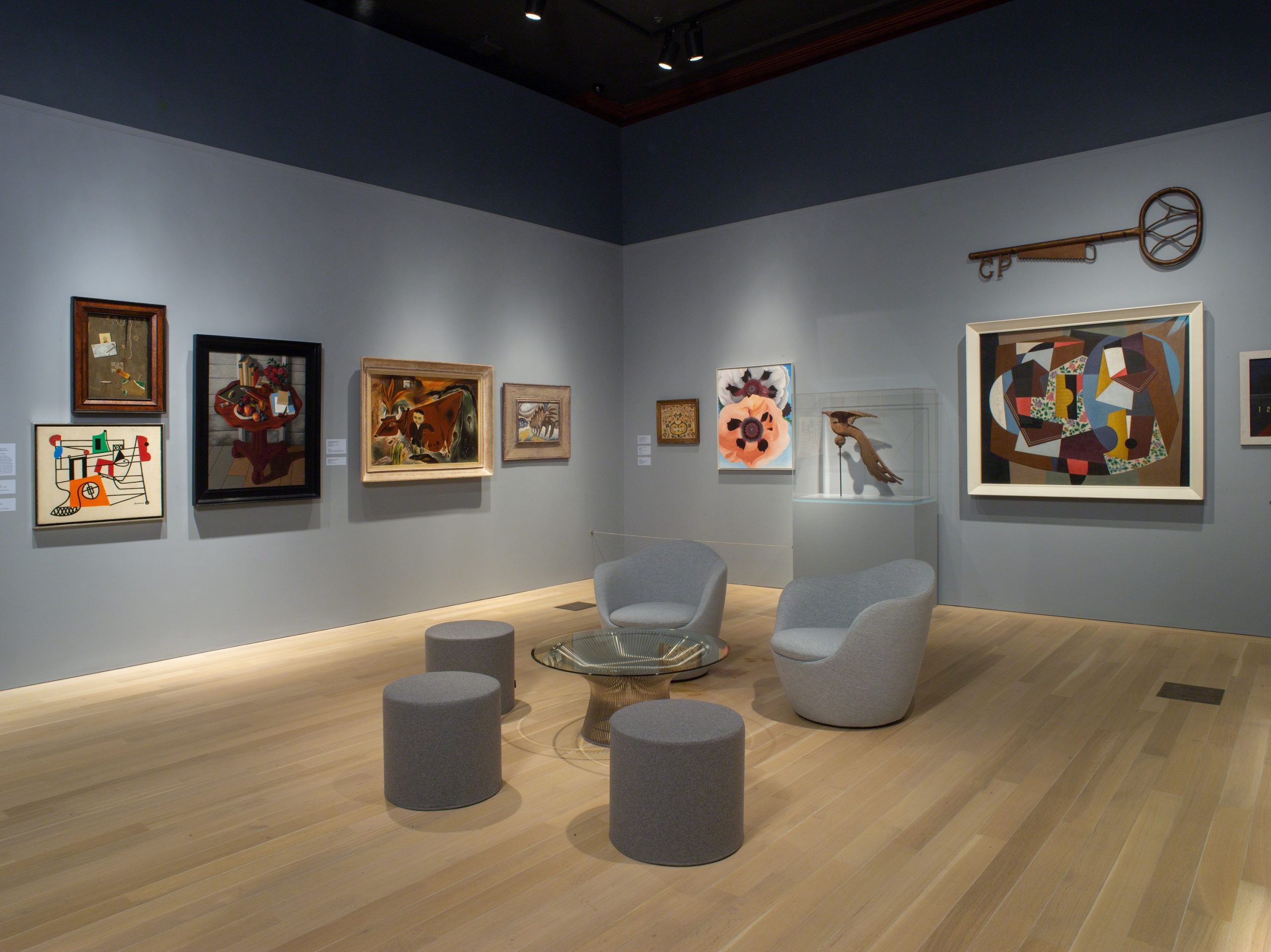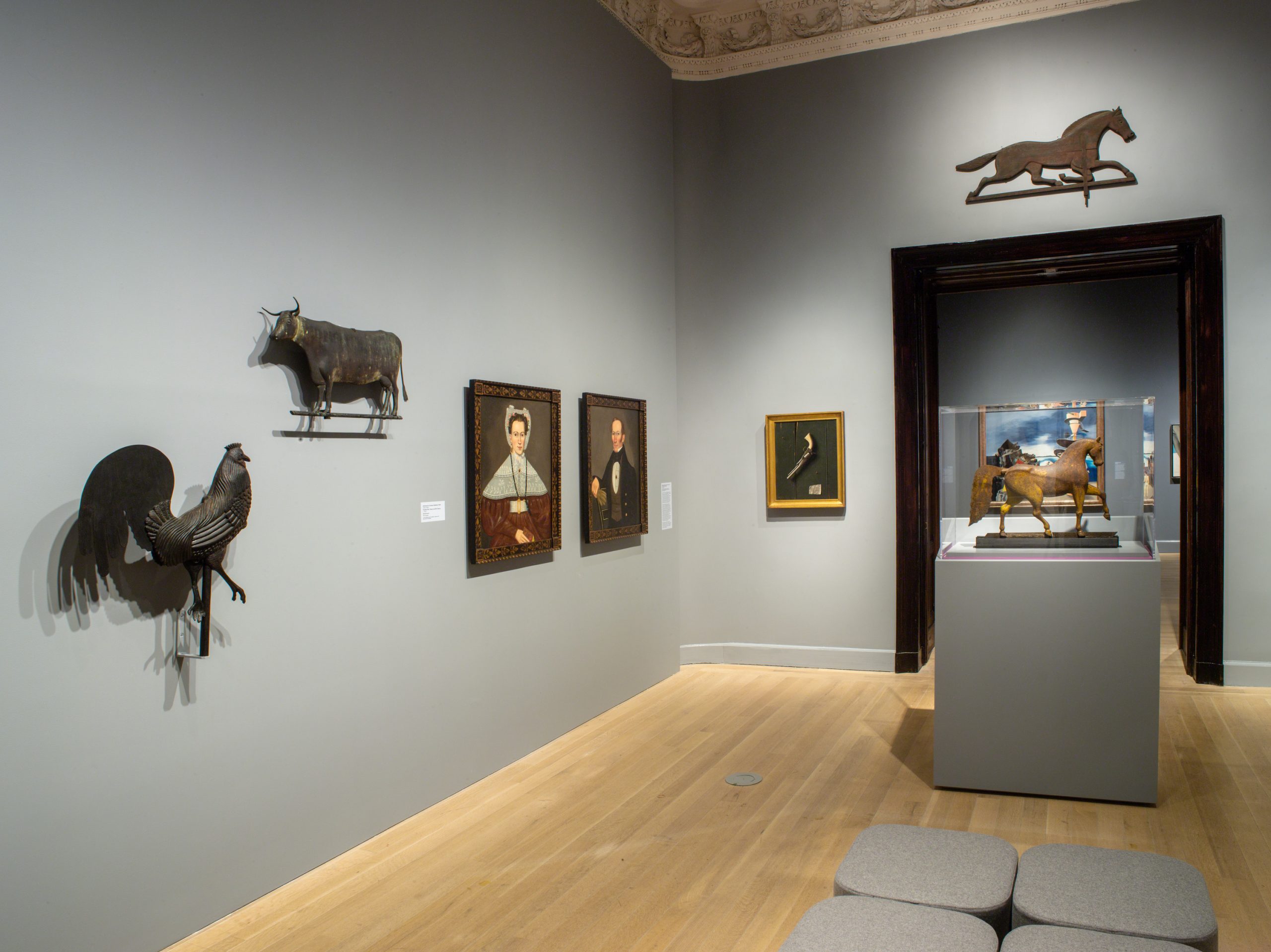Edith Halpert and the Rise of American Art
Curated by: Rebecca Shaykin
Exhibition schedule: The Jewish Museum, NY, October 18, 2019–February 9, 2020
Exhibition catalogue: Rebecca Shaykin, Edith Halpert, the Downtown Gallery, and the Rise of American Art, exh. cat. New York, NY: The Jewish Museum in association with Yale University Press, 2019. 232 pp.; Hardcover: $50.00 (ISBN: 030023100

The first thing you see when you enter Edith Halpert and the Rise of American Art at the Jewish Museum is a blown-up photograph from a 1952 issue of Life magazine featuring New York gallerist Edith Halpert in her midtown art space (fig. 1). Halpert, larger than life-size in the foreground, sits comfortably in a chair, legs and arms crossed. She is relaxed and confident as she gazes directly at the viewer. In the background are six of the many American artists Halpert represented at that time, all young white men, who are almost half the size of her, and all but one are partially covered by the paintings they hold or by Halpert herself. What is important to take away from this photograph, which was also used to advertise the Jewish Museum exhibition on subway posters and is the exhibition catalogue cover, is Halpert’s central place in the American art world. In a New York art scene dominated by men, particularly white men, Halpert not only created a name for herself but also helped establish the careers of many important American modernists, men and women alike. This photograph makes clear what the exhibition sets out to do: show audiences how Halpert selected, curated, and supported a diverse range of American artists from the 1920s until her death in 1970, and in doing so transformed the art market and standards of taste in the United States, all while elevating the status of women professionals in the art world.
Edith Halpert and the Rise of American Art is chronologically organized with a selection of artwork that Halpert was known to have exhibited, sold, or owned privately. The first of six rooms focuses on works Halpert showed during the early years of the gallery. The second room, much smaller than the others, exclusively features works on paper, and the third brings together historical American art and American folk art. The fourth and fifth rooms take a broad look at the folk art and contemporary art that Halpert sold in the 1940s and 1950s. The show ends with highlights from Halpert’s personal collection.
The first room, titled “Our Gallery,” after the name of Halpert’s gallery when it opened in 1926, illustrates the breadth of artists and media for which Halpert was famous. A jewel-toned tapestry by Marguerite Zorach (1917; Collection of Lucy Loewenheim Cohen) is paired with Elie Nadelman’s Seated Woman (c. 1919–1925; Addison Gallery of American Art), just as it had been in Halpert’s inaugural exhibition. On the next wall are examples of Stuart Davis’s early paintings, including his unusual New York—Paris No. 1 from 1931 (University of Iowa Museum of Art), a large canvas dominated by a high-heeled leg in a black stocking juxtaposed with a sideways Chrysler Building, a French café, and a sailboat, among other things. Balancing Davis’s work on the opposite side of the same wall is Charles Sheeler’s Americana (Metropolitan Museum of Art) dating to the same year. While their subject matter evokes two different time periods and two different worlds, their exploration of flatness, surface, and even color palettes are gratifyingly similar.
It is comparisons such as these, and more specifically the juxtapositions of diverse media in each room, that make Edith Halpert and the Rise of American Art so successful. With the exception of the second room, the rest of the exhibition compares and contrasts a rich diversity of makers, subjects, media, and sometimes even time periods. The two guiding principles for curator Rebecca Shaykin, as for Halpert herself, were American subject matter and a “modern” (which Halpert defined in many ways, as outlined in the exhibition catalogue) take on that subject matter. In “Our Gallery,” for example, the curator has compared embroidery to stone sculpture, aligned oil painting to watercolor and metalwork, and contrasted them all with Halpert’s own paper advertising brochures displayed in vitrines.

The juxtapositions within the room titled “Advancing American Art” were particularly illuminating. For instance, on a wall (fig. 2) where a giant key hangs over George Lovett Kingsland Morris’s cubist Wall-Painting (1936; Brooklyn Museum), Shaykin has deliberately placed a Pennsylvania German baptismal certificate (c.1805; Philadelphia Museum of Art) next to Georgia O’Keeffe’s Poppies (1950; Milwaukee Art Museum), to encourage comparisons. On the surface the two have nothing in common. While O’Keeffe’s work is a large canvas comprised of shades of red, peach, black, and very pale blue, the baptismal certificate is a small piece of off-white paper with somewhat faded yellow, blue, orange, and green. O’Keeffe’s work is a depiction of two poppies seen from close up: not exactly detailed, but still objectivity recorded. Meanwhile, the baptismal certificate depicts small flowers, hearts, angels, and text all carefully applied with ink and watercolor to create a symmetrical pattern. And yet, after careful inspection, similarities become obvious. Both works emphasize pattern, ornament, patches of bold color, and repetition. The overall forms within both compositions are decidedly similar. Of course, it is unlikely that O’Keeffe saw this particular work, and she was not known to have been influenced by the work of Pennsylvania Germans (although some of her colleagues were.) What Shaykin is doing here is illustrating the way in which Halpert identified formal links between the seemingly disparate works she was collecting and exhibiting, specifically between American folk art, a category she helped to define, and American contemporary art. Halpert advertised folk art as the roots of an American modernism and enjoyed locating examples that proved her point. Shaykin is using this O’Keeffe and Pennsylvania German comparison to illustrate an argument Halpert made regularly in her gallery shows.
The intimate rooms of the Jewish Museum and the crisp gray color on the walls serve these juxtapositions well. Paintings and metalwork “pop,” and the white ceiling and crown moldings create a halo effect, making each room appear to almost glow. Chain curtains are used to frame some of the sculpture and create a dramatic visual effect aided by carefully placed spotlights. And yet, despite the fact that Halpert was Jewish herself and supported Jewish artists, I could not help but feel that the Jewish Museum was an odd space for a Halpert exhibition. Halpert was a champion of modernist design. She designed her galleries with the help of more established modernist architects and furniture makers. They featured the most up-to-date design trends, and Halpert herself invented interior elements such as Metalush, a metal curtain used to decorate walls. Though Shaykin and the Jewish Museum exhibitions team were not trying to recreate the Downtown Gallery, to see these works on the walls of the 1904 Felix Warburg mansion removes them from the era when they were created and partially ignores the middle-class audience Halpert was trying to attract to her gallery. Curators did attempt to include modernist elements, such as swivel chairs in the final room (a must for every incarnation of Halpert’s gallery), but the works do lose some of their once cutting-edge quality in such a historical building.
The exhibition space does not look much like Halpert’s actual galleries, although Edith Halpert and the Rise of American Art still conjures the spirit of Halpert and achieves its educational goal. Through the thoughtful wall text and exhibition catalogue, viewers and readers learn about Halpert’s life, influence, and a specific American art scene of the 1920s to the 1960s. While the curators are successful in teaching their lessons visually, encouraging viewers to understand Halpert’s innovative curatorial practices, it is really the exhibition catalogue where Halpert’s accomplishments are made most clear. Organized chronologically and with mostly the same subdivisions as the exhibition itself, the publication is filled with archival photographs and exhibition histories that offer a compelling case for the importance of Halpert, her Downtown Gallery, and her side projects on the American art world (two highly praised exhibitions she organized outside of her gallery included the Municipal Art Exhibition in Atlantic City, New Jersey in 1929 and the First Municipal Art Exhibition at Rockefeller Center in 1934). The catalogue is well researched and a good read, and is an important companion to the show.
There are many lessons to be taken from the exhibition and its catalogue. Two resonated with me in particular. First, Halpert deserves credit for trying to expand the parameters of American art to include other types of art like folk art, industrial design, and objects of material culture. This is made clear not only in the catalogue but also in the third gallery, titled “American Ancestors,” where Shaykin illustrates Halpert’s interest in and promotion of historical American art and material culture by covering the walls with weathervanes and colonial portraiture (fig. 3). Moreover, this room creates a sense of how Halpert elevated the status of these objects. While weathervanes, colonial portraits, and trompe l’oeil paintings were understood as collectible objects of Americana, once Halpert began selling them, she raised their market value and encouraged museums to see them as objects worth owning.

Finally, Halpert’s definition of American art was highly inclusive. One of the problems I initially had with the photograph that starts the show is the lack of diversity it presents. To depict Halpert with six young white men does not do justice to her larger project (and says more about Life magazine’s understanding of who was an American artist in 1952 than Halpert’s.) Another photograph in the Life article, reproduced in the exhibition catalogue, shows Halpert’s more established artists, includes Jacob Lawrence and Yasuo Kuniyoshi but does not depict any of her female artists. Something that Shaykin does well in Edith Halpert and the Rise of American Art is demonstrate Halpert’s commitment to a diverse range of talent. She sets the tone right at the start by beginning the exhibition with the Zorach and Nadelman pairing. In the “Picture Boom” gallery, works by Lawrence and Horace Pippin dominate the first wall (Halpert was one of the first white art world professionals to collect and sell contemporary African American art). Lawrence has four works in the show, more than any other artist with the exception of Sheeler and Davis.
It is precisely the theme of diversity that stayed with me when I left the exhibition. Surely there were other women and also people of color who, like Halpert, worked tirelessly behind the scenes to promote contemporary American art, but who were they? Students of American art history know a great deal about Alfred Stieglitz, Holger Cahill, and Alfred Barr, but what about their female and/or nonwhite counterparts? After reading the catalogue, it became clear that more work remains to be done on the collector and Museum of Modern Art founder, Abby Aldrich Rockefeller; director of the Société Anonyme, Katherine Dreier; the first director of the Whitney Museum of American Art, Juliana Force; and founders of the first black-owned commercial art space, Alonzo J. Aden and James V. Herring, all of whom played important roles in curating, collecting, and establishing audiences for contemporary art produced all over North America in the 1920s, 1930s, and 1940s, but none of whom have received a great deal of scholarly attention (although work on Aden and Herring is forthcoming from The Phillips Collection.) What is so important to take away from Shaykin’s work is that she identified Halpert as an important voice, worthy of study and attention. It is now up to other curators, academics, museums, and institutions to continue to put forth and encourage the study of other voices who worked tirelessly to promote modernism in this interwar period in the United States. In doing so, the definition and understanding of modernism will undoubtedly expand.
Cite this article: Eliza Butler, review of Edith Halpert and the Rise of American Art, The Jewish Museum, New York, Panorama: Journal of the Association of Historians of American Art 6, no. 1 (Spring 2020), https://doi.org/10.24926/24716839.10043.
PDF: Butler, review of Edith Halpert and the Rise of American Art
About the Author(s): Eliza Butler is a Core Lecturer for Art Humanities at Columbia University

